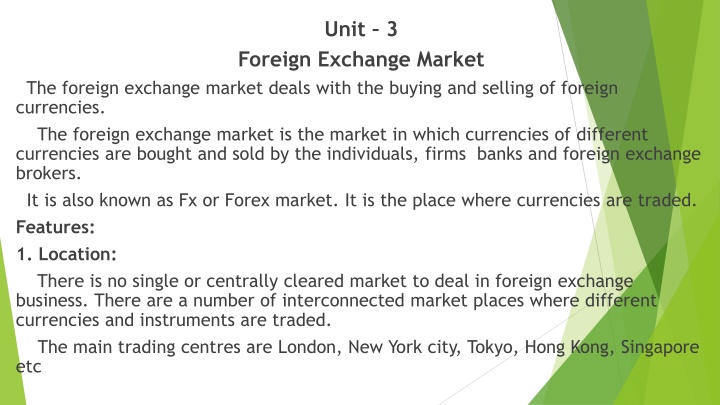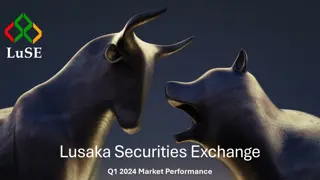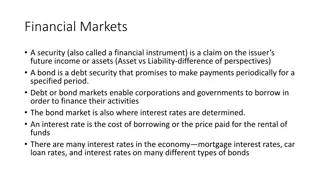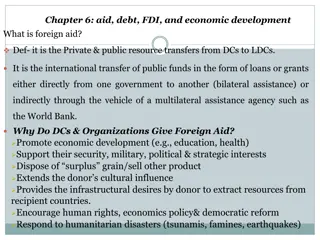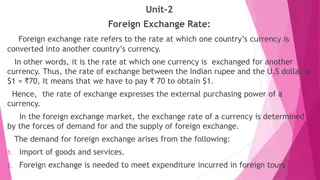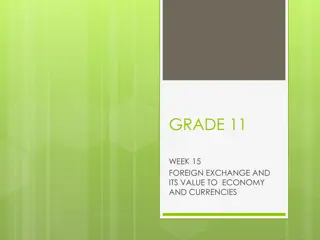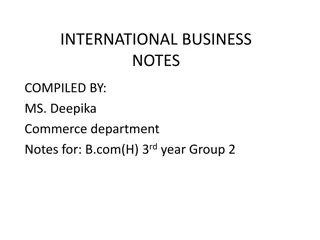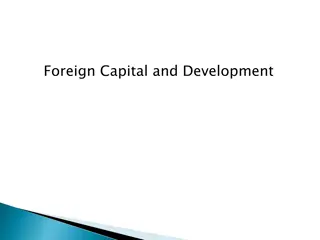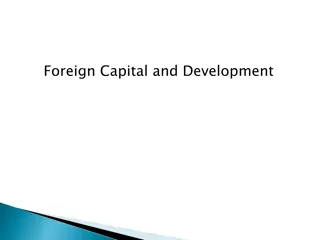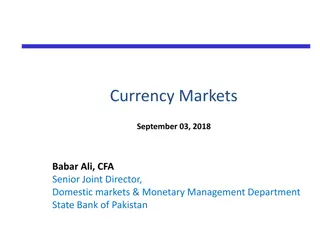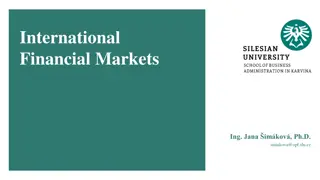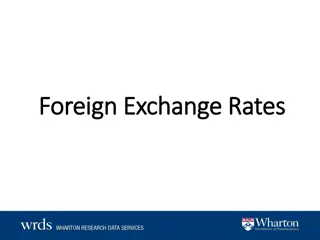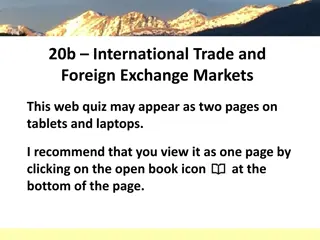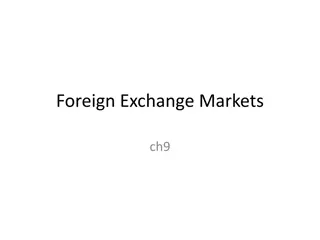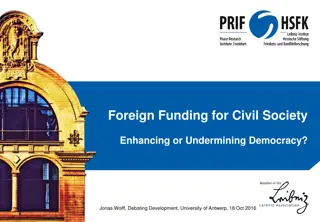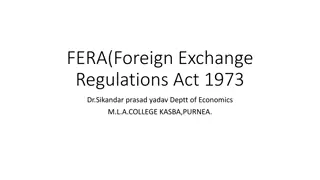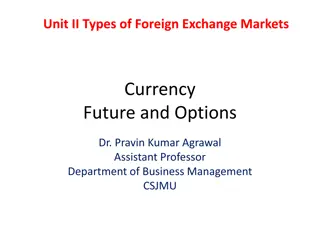Overview of the Foreign Exchange Market
The foreign exchange market, also known as the Fx or Forex market, is a global marketplace for buying and selling foreign currencies. It is decentralized and operates 24 hours a day across various financial hubs worldwide. Major participants include commercial banks, corporates, and entrepreneurs. The market is influenced by economic policies, conditions, and political events. Currencies traded include the Dollar, Euro, Yen, and more.
Download Presentation

Please find below an Image/Link to download the presentation.
The content on the website is provided AS IS for your information and personal use only. It may not be sold, licensed, or shared on other websites without obtaining consent from the author.If you encounter any issues during the download, it is possible that the publisher has removed the file from their server.
You are allowed to download the files provided on this website for personal or commercial use, subject to the condition that they are used lawfully. All files are the property of their respective owners.
The content on the website is provided AS IS for your information and personal use only. It may not be sold, licensed, or shared on other websites without obtaining consent from the author.
E N D
Presentation Transcript
Unit 3 Foreign Exchange Market The foreign exchange market deals with the buying and selling of foreign currencies. The foreign exchange market is the market in which currencies of different currencies are bought and sold by the individuals, firms banks and foreign exchange brokers. It is also known as Fx or Forex market. It is the place where currencies are traded. Features: 1. Location: There is no single or centrally cleared market to deal in foreign exchange business. There are a number of interconnected market places where different currencies and instruments are traded. The main trading centres are London, New York city, Tokyo, Hong Kong, Singapore etc
2. Size of the market: It constitutes the largest financial market. Trading between foreign exchange dealers are very large, involving hundreds of millions of dollars. It is most liquid financial market in the world. 3. 24 hours market: The foreign exchange markets are situated throughout the different zones of the globe. When one market is closing, the other is beginning it operates. Thus any point of time one market or the other market is open. 4. Efficiency: The efficiency of the Forex market has been made possible by tremendous development in communication. Any development in any market is immediately received by the other markets across the globe. 5. Currencies traded: The major currencies traded in foreign exchange market are Dollar, Euro, Yen, Pound, Australian Dollar, Swiss Franc, Indian rupee.
6. Physical Markets: It may be noted that in few cases, like Paris and Brussels, foreign exchange transaction takes place at a fixed place such as, the local stock exchange buildings. 7. Types of foreign exchange market: The Forex market can be classified into 2 types- Retail Forex market and wholesale Forex market. When individuals like, travellers, tourists, students and small entrepreneurs involved in exchange in foreign currency into home currency and vice versa. Such foreign exchange market is known as Retail foreign exchange market. In wholesale foreign exchange market, medium size and giant corporates are involved in foreign exchange transactions. 8. Factors influencing exchange rate: The foreign exchange market is influenced by variety of factors. It includes, economic policy of govt and economic condition of the country. Internal, regional and international political of the conditions have effect on currency market. ------- -------- ---------
Participants of the foreign exchange market: 1. Commercial banks: They occupy important position in the foreign exchange market. They operate by buying and selling foreign currency for their clients. For scale transaction banks may deal directly among themselves. But for smaller transactions, the intermediation of foreign exchange brokers may be used. For the banks foreign exchange dealing is a specialized activity with good potential for profit. To carryout foreign transactions banks have to keep sufficient stocks of foreign exchange. These are kept in the form of bank accounts abroad. 2. Corporates and Entrepreneurs: Corporates are the players in the foreign exchange market to satisfy their need of payment in foreign currency towards import of goods and services. Corporates comprise of business houses, international investors and MNCs. They operate in the foreign exchange market to meet their trade or investment needs.
3. Foreign exchange brokers: They do not buy or sell foreign currency on their own account. They work as link between buyers and sellers of foreign currencies. They are the major sources of market information. They earn only the fee in the form of brokerage charges. It is through the foreign exchange brokers that commercial banks undertake their foreign exchange inflows among themselves. 4.Central Banks: The central bank of a country also takes part in the foreign exchange market. It act as the custodian of foreign exchange reserves of its country. it also manages exchange control. It intervenes in the foreign exchange market in order to stabilize the exchange rate of the country s currency. In addition, the central banks buy and sells foreign exchange. When the rate market of currency reaches the upper line, the central bank increases the sale of it s currency in exchange for other currencies. On the other hand, when the market rate of currency reaches the lower line, the central bank buys it s currency and sells foreign currencies
5. Non bank foreign exchange companies: These companies offer currency exchange & international payments to private individuals and companies. These companies offer better exchange rates or cheaper payments than the customer s banks. 6. Money transfer remittance companies: These companies also perform high volume low value transfers generally by economic migrants back to their home country. The largest and best known provided is Western Union with 3,45,000 agents, followed by UAE exchange. 7. Foreign exchange banks: They are joint stock banks incorporated in foreign countries and operating in the other countries. They are engaged mainly in the financing of foreign trade. In India, there are 30 foreign exchange banks.
Functions of foreign exchange market: 1. Transfer function: The most importance function of the foreign exchange market is the transfer of purchasing power from one country to another and converting one currency to another. The rate at which one currency is converted into another is called the exchange rate. The foreign exchange market perform the transfer function by using a variety of credit instrument. Such as, telegraphic transfers, mail transfers bank drafts, foreign bills etc. Recent development: Some of the important recent developments taken place in transferring purchasing power from one country to another are, a. SWIFT: The Society of World-wide Interbank Financial Transactions is a co-operative society registered in Brussels, Belgium and about 250 banks situated in Europe and North America are its members. Few selected banks in India have became its members. SWIFT network supports to transmit the information relating to messages and support to foreign exchange transactions.
b. CHIPS: It means Clearing House Inter-bank Payment System . It is an electronic payment system. It is owned by 12 private commercial banks constituting the New York clearing house association. It is the world largest foreign exchange payment system. c. CHAPS: It represents Clearing House Automated Payments System It is an electronic payment system among the banks at London and other countries. d. Fed Wire: The Fed Wire System has been developed by the federal reserve system of U.S.A in order to satisfy the need of domestic payments, interbank transfers etc. It is a communication network that links more than 7000 banks of the Federal Reserve Banks.
2. Credit function: The foreign exchange market performs the credit function both nationally and internationally to promote foreign trade. The important function performed by the foreign exchange department of a bank is providing credit facilities to the exporter and importers. a. Export credit: Commercial banks provides 2 types of export credit. They are Pre-shipment credit Post-shipment credit b. Import Credit: To finance imports, the foreign exchange department of a bank issue letters of credit on behalf of their importer-customers. The importers will be financed in the following two forms: a. Cash credit or loan b. Pledge or mortgage of the items imported. i. ii.
The availability of foreign currency is assured to the following main sources. a. Euro currency market: It is the international financial market, which specialises in the borrowing and lending of the U.S. dollars and other European currencies, outside their respective countries of issue. Its centres include London, Paris, Frankfurt, Zurich, etc. b. Export Credit Facilities: These facilities are available by several countries through an institutional frame work in which the EXIM banks plays a vital role. c. International Bond Market: This market provides facilities to raise long-term loans by using different types of instruments. It is famously known as Euro Bond Market. d. International Financial Institutions: It includes IMF, World Bank, IFC, IDA, ADB ,etc. provides finance in foreign currencies.
3. Hedging Functions: Hedging of foreign exchange risk is the another important function performed by the foreign exchange market. This function is performed by a way of providing facilities for buying and selling spot or forward exchange control. In a forward exchange contract a banker or a customer or another banker entire into a contract to buy or sell a fixed amount of foreign currency on a specified future date, at a pre-determined rate of exchange. In this way the exporters and importers can hedge their foreign exchange risk, arise from sudden and unexpected changes in foreign exchange rate. Thus, the forward exchange contracts enable the banks, to fix exchange position in a foreign exchange market.
Instruments Traded in Foreign Exchange Market: 1. Telegraphic transfer (TT): It is a quickest method of transferring money from one centre to another. A TT is an order for the payment of money sent by telegraph or cable. The customer purchasing a TT pays the money to the bank in the currency of his country. The bank informs it s banking correspondent through oversees cable communication service to make payment in foreign currency to a specified payee. The cost of the telegram cable is included by the selling bank in the amount recovered. Advantages: 1. It is the quickest method of transferring funds from one country to another. 2. There is no gain or loss of interest. 3. There is no risk of loss of instrument in the transaction. 4. It is the more safe and principal means of effecting international payment.
2. Mail transfer: (MT) It is an order by a bank to it's a correspondent bank in abroad to pay a specific amount of money to a particular person. The instructions are sent by mail usually by air mail. A mail-transfer is like a cheque effecting payment or transfer of funds but is not negotiable or transferable. Mail transfer has the following disadvantages: 1. It is time consuming as it takes much time to reach it s destination. 2. There is loss of interest to the purchaser. 3. There is loss of instrument during transaction. 3. Bank drafts and cheques: A bank draft is a pay order issued by a bank on its own branch or correspondent bank abroad. The bank draft or demand draft is handed over to the buyer who sends it to the beneficiary. The beneficiary obtains payments on presentation to the bank on which the draft is drawn.
The name of the beneficiary is indicated on the draft or cheque. Banks charge commission for issuing the bank draft and direct the branch manager of that country to pay the specified amount in foreign exchange to the beneficiary. It may be noted that a draft may be drawn in the currency of the country where the debtor resides. The drawback of remittances by draft or cheque is the risk of loss of draft or cheque in transit and delay in effecting the payment to the beneficiary. It involves the loss of interest as like mail transfer. 4. Bill of exchange: It is a written order issued by the exporter through which the importer is directed to pay the specified amount in specific currency on a specified date to him or his representative. There are 3 parties involved in a bill of exchange, They are: a. The drawer b. The drawee c. The payee
The drawer is the exporter or the future receiver of funds. The drawee is the person or the firm who is liable to pay the funds. The payee is the person who is entitled to receive the funds other than the drawer. An exporter prepares a bill of exchange which is drawn on an overseas importer or an a third party designated in the export contract for the sum agreed. The bill of exchange is classified into sight draft and term draft. The Sight draft is payable at sight or on demand. But Term draft is payable at a fixed or determinable future time. It is also called as Usance bill. Further, bills are also classified into trade bills and bank bills. Trade bills arise out of trade transactions, while bank bills include bank drafts and commercial bills which are accepted by the banks.
5. Letter of Credit: It is a document issued by a banker of the importer. Through the letter of credit, the bank agrees to honour a draft drawn on the importer, subject to conditions. It is an instrument authorising a person to draw a bill or a cheque for a specific sum on the issuing bank at a specific time. An importer in a country requests his bank to open a credit in foreign currency in favour of his exporter at a bank in the foreign country. It is issued against the payment of amount by the importer or against proper security. The letter of credit authorises the exporter to draw a draft under its terms and sell to a specified bank in his country. The LOC make the exporter willing to ship the goods to the importer for the payment is assumed by the bank. 6. Bill of Lading: It is a shipping document issued to an exporter firm or its bank by the transport agency or the transporter. It is a evidence that the transporter is required to deliver the goods to the importer in exchange for certain charges, as an evidence of the ownership of goods.
Methods of Quoting Exchange Rates: The rate of exchange for a currency is known from the quotation in the foreign exchange market. In foreign exchange dealing the rate of exchange can be quoted in two methods. 1. Direct Quotation: (Buy low, Sell high) In this method, exchange rate is expressed as the price per unit of foreign currency in terms of the home currency. It is also known as home currency quotation. Under the direct quotation, the number of units of foreign currency is kept constant and any change in the exchange rate will be made by changing the value of in terms of home currency. Under this method, home currency will be the variable unit. For eg: 1 US Dollar= 71 1 Euro= 78 1 Pound= 92
Direct Quotation Sell high Buy low For a fixed unit of foreign currency Receive more units of home currency Pay lesser units of home currency In foreign exchange market, the banker buy the foreign currency at a lower rate and sells at a higher rate to earn a margin. For example, a bank may buy U.S.$ from its customer for Rs. 71.94 and sell it to another customer at Rs. 72.14
2. Indirect Method ( Buy high and Sell low ): Under this method, the foreign exchange rate is expressed as number of units of foreign currency per unit of home currency. In this method, home currency is kept constant and exchange rate is expressed as so many units of foreign currency quotation. Under this method, the foreign currency will be variable units. Any change in foreign exchange rate will be effected by change in the units of foreign currency. For eg: 100=2.5 US 100=1.5 Pound 100=2.1 Euro
Indirect Quotation Sell low Buy high For a fixed unit of home currency Part with lesser units of foreign currency Acquire more units of foreign currency In this method, the banker buys the foreign currency at a higher price from a customer and sells at a lower price to another customer For eg For 100 the bank may quote a selling rate of dollar 2.3290 and buying rate Dollar 2.3390 In India, till 1966. direct quotation was introduced. But after 1993, India has adopted direct quotation. the indirect quotation is used in London. Both methods are used in USA.
FEDAI ( Foreign Exchange Dealers Association of India ): It is the association of all dealers in foreign exchange which determines rules and regulation relating to day to day transaction in foreign exchange business in India. It was formed with the approval RBI in 1958. It act as a self regulatory body and is incorporated under the section 25 the Companies Act 1956. Its major activities include framing of rule, governing the conduct of inter-bank foreign exchange business among banks and the public and works with RBI for reforms and development of Forex market. All public sector banks, foreign banks, private sector and co-operative banks and certain financial institutions are the members of FEDAI. It has its headquarter in Mumbai and local offices at Bengaluru, Kolkata, Chennai and Delhi.
Management FEDAI s management consists of: a. Chairman. b. Vice-chairman. c. Additional Vice-chairman. d. Managing committee. Functions The following are the main functions performed by FEDAI: 1. Framing rules: The FEDAI is the authority to frame rules for the conduct of foreign exchange business in India. All the member are required to abide by the rules framed by FEDAI.
2. Coordination: The FEDAI coordinates with the RBI in the proper administration of exchange control. 3. Circulating information: The FEDAI circulates information about foreign exchange business, international trade etc. Which will be of use and interest to its member. It acts as a clearing house for exchange information among its members. 4. Training: The FEDAI assists member banks by acting as an advisor and assists with the training of personnel. It undertakes various sessions/workshops/seminars with the main objective of educating exporters in their day-to-day transactions with the banks.
Role and responsibilities of FEDAI: 1. Formulation of FEDAI guidelines and FEDAI rules foreign exchange business. 2. Training of bank personnel in the areas of foreign exchange business. 3. Accreditation of foreign exchange brokers. 4. Advising or assisting member banks is settling issues or matters in their dealings. 5. Representing member banks or government or RBI and other bodies. 6. Announcement of daily and periodical rates to its member. ********************************
